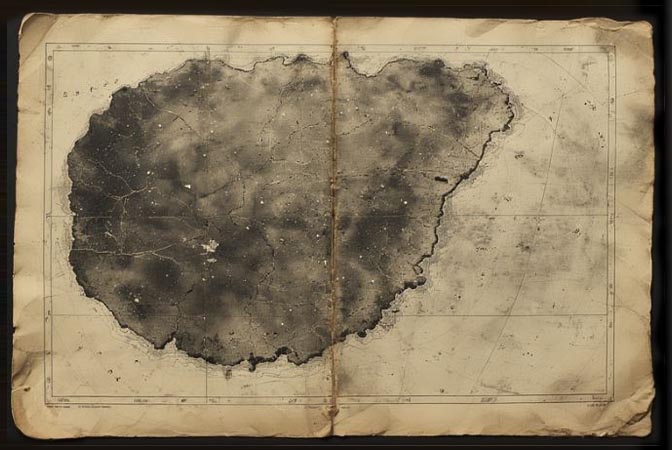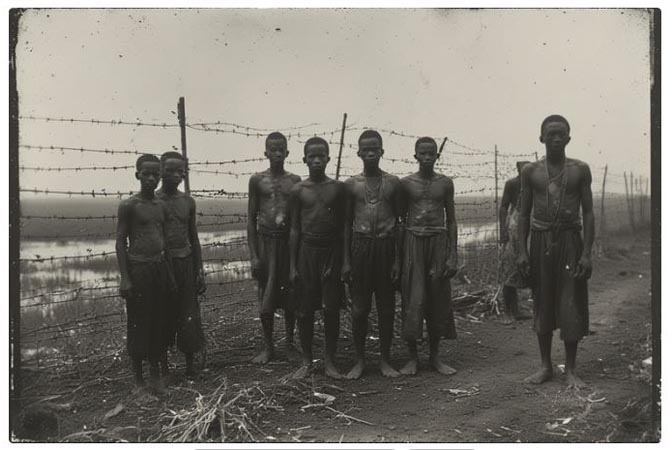You can’t
really read through this article. You
can only enter, linger, and leap on –
like joining a conversation with no
centre.
Fissures open between the lines of official maps—places that ought not to exist, or were never meant to. The Maratongo Delta is one such place: a geo-cultural phantom that appears fleetingly in early colonial sources and vanishes from later records. What remains are fragments—maps, reports, images, sounds. Traces, nothing more. An attempt to read what has been erased: a speculative cartography of absence.
A Case Study: The Ethnographic Report by Dr H. Renk (1924) – Extract with Footnotes
The so-called Camp Maratongo could only be observed from a distance; any attempt at direct approach was met with firm refusal. The local population consistently withheld information, responding with silence or evasive gestures. The camp itself appeared as a provisional yet remarkably well-structured facility. Despite its apparent order, there was a complete absence of cultural artefacts or traditional objects—an absence that suggests a deliberate dismantling or erasure of familiar communal structures.¹This lack of established cultural markers may indicate that the camp served not only an administrative function, but also operated as an instrument of control and disciplinary restructuring—a site where identities were dismantled and reassembled.² The visible efficiency of the camp's internal organisation stands in stark contrast to the linguistic and social absence of its inhabitants, whose histories and lifeways appear either silenced or erased.
The investigation was hindered by an insurmountable distance—both physical and symbolic—raising the question of whether the Maratongo Delta represents a site of actual events or a cartographic phantom shaped by colonial projections of power.³
Footnotes
¹
The absence of cultural artefacts may
point to the systematic removal or
destruction of traditional material
culture—a method frequently employed in
colonial camps to undermine indigenous
identity. Whether this absence is
entirely factual or partially symbolic
remains unresolved.
² Camp Maratongo may be interpreted as a disciplinary space in which pre-existing social structures were fragmented and replaced by an imposed, externally controlled order. This reading aligns with contemporary theories of colonial power and control (see Foucault 1975).
³ The ambiguous mapping and subsequent disappearance of the site in later sources suggest that the Maratongo Delta may be less a real location than a projection space shaped by colonial anxiety and uncertainty. Here, the boundaries between reality and phantom blur.
Field Notes / Expedition Journal – Extracts from March 1924 (Dr H Renk)
12 March 1924A sweetly musty odour hangs in the air—not quite foul, not fresh either, but something indeterminate and hard to define. The porters refuse to enter the water. One whispers, with noticeable unease: “That is where the paths disappear.” I record the words without understanding their full meaning.
Marginal note: „Unclear whether metaphorical or literal – early signs of fear?“
see the film fragment
14 March 1924
The 1912 map clearly indicates a camp in this area. Yet on site: nothing but dense fog and distant traces of smoke, the origin of which no one can explain. Time appears unstable—light and shadow shift with no discernible rhythm. My notes seem distorted, as if reality itself were warping before my eyes.
Marginal note: „Optical illusion? Illness? Something atmospheric?“
see the film fragment
17 March 1924
Voices during the night—indistinct, distant. No identifiable direction to the sound. My assistant insists they were coming ‘from beneath the waterline’. Whatever that may mean, it adds yet another unsettling layer to this place.
Marginal note: „Unexplained acoustic phenomena – atmospheric interference?“
see the film fragment
18 March 1924
Found a corroded metal tag in the mud, engraved: “M.G.B. – Section 7”. I kept it, yet by the next morning it had disappeared—as though the delta had reclaimed it.
Marginal note: „Loss of artefact unexplained – sabotage? Natural process?“
see the film fragment

